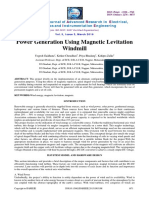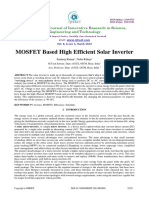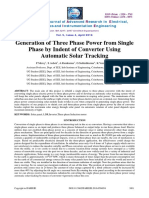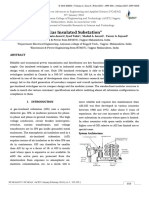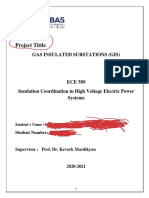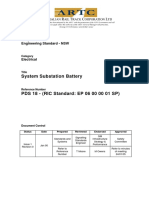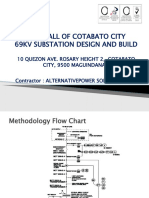23 - A Study
23 - A Study
Uploaded by
Sherry SherCopyright:
Available Formats
23 - A Study
23 - A Study
Uploaded by
Sherry SherOriginal Title
Copyright
Available Formats
Share this document
Did you find this document useful?
Is this content inappropriate?
Copyright:
Available Formats
23 - A Study
23 - A Study
Uploaded by
Sherry SherCopyright:
Available Formats
ISSN (Print) : 2320 – 3765
ISSN (Online): 2278 – 8875
International Journal of Advanced Research in Electrical,
Electronics and Instrumentation Engineering
(An ISO 3297: 2007 Certified Organization)
Vol. 5, Issue 6, June 2016
A Study on Gas Insulated Substation with
Reference to 220/33kV GIS, Khanapara
Bipul Kumar Talukdar*, Suranjana Bharadwaj
Assistant Professor, Dept. of EE, Girijananda Chowdhury Institute of Management & Technology, Guwahati, India
*Corresponding author
ABSTRACT: Due to rapid industrialization and increasing population all over the world, the need of efficient and
reliable power source has become the prime demand. But since geographic area has reduced due to increasing
population, creation of a compact but efficient power supplying medium is required. Gas Insulated Substation is the
solution to such problems. Gas Insulated Substation uses Sulfur hexafluoride (SF6) gas which has a superior dielectric
properties used at moderate pressure for phase to phase and phase to ground insulation. In Gas Insulated Substationthe
high-voltage conductors, circuit breaker interrupters, switches, current transformers, voltage transformers and lightning
arresters are encapsulated in SF6 gas inside grounded metal enclosures. Because of its compact nature, the size of the
plant is reduced and hence the space consumed is decreased. This paper presents a study of Gas Insulated Substation
(GIS) with reference to the 220/33kV GIS, Khanapara in Guwahati.
KEYWORDS: Gas Insulated Substation, GIS, Air Insulated Substation, 220/33kV GIS Khanapara
I. INTRODUCTION
Globally economy and population continues to grow which results in rise of electrical power requirements. For this
purpose, substation equipment has to be made more efficient and reliable to cope up with increase in demand,
especially adapting current power distribution and transmission system [1]. Although in last few years an important
development has been made by integration of Smart Metering (AMI) and Smart Grid technology, but this technology
limits itself only in distribution phase as it directly related to communication between consumer and demand. We all
know that power is produced, then transmitted and then distributed through Grid Stations or Sub-stations. For more
efficiency the transmission and distribution sector has to be improved and it is found that construction of Gas Insulated
Substation [GIS] is a further step for better efficiency. [1, 2]
GIS uses Sulfur hexafluoride (SF6) gas which has a superior dielectric properties used at moderate pressure for phase to
phase and phase to ground insulation. In this type of substation,the high-voltage conductors, circuit breaker
interrupters, switches, current transformers, voltage transformers and lightning arresters are encapsulated in SF6 gas
inside grounded metal enclosures. GIS is used when space is to be provide a high position in the big cities.in case of
Air Insulated Substations (AIS) clearance between phase to phase and phase to ground need to be very large. For this
reason, a large space is required in AIS. But as the dielectric strength of SF6 gas is much higher relative to the air,
necessary for phase to phase and ground clearance for all equipment are much lower in GIS which results in significant
reduction of sub-station size.
GIS is preferable in following places.
Smart cities, metros, cities and towns
Under ground stations
Substations and power plants located off shore
Hilly areas and valley regions
In this paper, a theoretical study of Gas Insulated Substation (GIS) is presented with special reference to the 220/33kV
GIS, Khanapara, located in Guwahati, India.
Copyright to IJAREEIE DOI:10.15662/IJAREEIE.2016.0506023 4672
ISSN (Print) : 2320 – 3765
ISSN (Online): 2278 – 8875
International Journal of Advanced Research in Electrical,
Electronics and Instrumentation Engineering
(An ISO 3297: 2007 Certified Organization)
Vol. 5, Issue 6, June 2016
II. CONSTRUCTIONAL FEATURES
Gas Insulated Substation contains the same compartments found in AIS. Only live parts are enclosed in metal body
filled with a dielectric gas such as SF6. The active parts are supported on insulators molten resin. Some of these bushes
are designed as barriers between adjacent modules such that the gas does not pass through them. The entire system is
divided into compartments which are relative to the other gas-tight. Thus, the gas detection system in each
compartment can be independent and simpler. The housings are of nonmagnetic materials such as aluminium or
stainless steel and are connected to ground [1]. The Main components of GIS are shown in Fig.1.
Fig.1: Components of GIS
III. ARRANGEMENT AND MODULES
Arrangement:The arrangement of GIS is single-phase or three-phase enclosed. The assembly consists of
completely separate pressurized sections designed to minimize the risk of damage to personnel or adjacent
sections in the event of a failure occurring within the equipment. Rupture diaphragms is provided to prevent
the enclosures from uncontrolled bursting and suitable deflectors provide protection for the operating
Copyright to IJAREEIE DOI:10.15662/IJAREEIE.2016.0506023 4673
ISSN (Print) : 2320 – 3765
ISSN (Online): 2278 – 8875
International Journal of Advanced Research in Electrical,
Electronics and Instrumentation Engineering
(An ISO 3297: 2007 Certified Organization)
Vol. 5, Issue 6, June 2016
personnel. In order to achieve maximum operating reliability, no internal relief devices may be installed so
that adjacent compartments would not be affected. Modular design, complete segregation, arc-proof bushings
and “plug-in” connection pieces allow ready removal of any section and replacement with minimum
disturbance of the remaining pressurized switchgear.
Bus-bars:All bus-bars are three-phase or single phase enclosed and plug-connected from bay to bay.
Circuit-breakers: The circuit-breaker is usually of the single pressure type with one interrupter per phase.
The arc chambers and contacts of the circuit-breaker are freely accessible. The circuit-breaker is designed to
minimize switching over voltages and also to be suitable for out-of-phase switching. The specified arc
interruption performance must be consistent over the entire operating range, from line-charging currents to full
short-circuit currents.The circuit breaker is designed to withstand at least 18–20 operations (depending on the
voltage level) at full short-circuit rating without the necessity to open the circuit-breaker for service or
maintenance. The maximum tolerance for phase disagreement is 3 ms, i.e. until the last pole has been closed
or opened respectively after the first. A standard station battery required for control and tripping may also be
used for recharging the operating mechanism. The energy storage system (hydraulic or spring operating
system) will hold sufficient energy for all standard IEC close open duty cycles. The control system provides
alarm signals and internal interlocks, but inhibit tripping or closing of the circuit-breaker when there is
insufficient energy capacity in the energy storage system, or the SF6 density within the circuit-breaker has
dropped below a minimum permissible level.
Disconnectors: All isolating switches are of the single break type. DC motor operation (110, 125, 220 or 250
V), completely suitable for remote operation, and a manual emergency drive mechanism is required. Each
motor-drive should be self-contained and equipped with auxiliary switches in addition to the mechanical
indicators.
Grounding switches: Work-in-progress grounding switches are generally provided on either side of the
circuit-breaker. Additional grounding switches may be used for the grounding of bus sections or other groups
of the assembly. DC motor operation (110, 125, 220 or 250 V), completely suitable for remote operation, and
a manual emergency drive mechanism is required. Each motor drive should be self-contained and equipped
with auxiliary position switches in addition to the mechanical indicators.
Instrument transformers: Current transformers (CTs) are of the dry-type design not using epoxy resin as
insulation material. Voltage transformers are of the inductive type, with ratings up to 200 VA. They are foil-
gas-insulated.
Cable terminations: The cable end housing should be suitable for oil-type, gas-pressure-type and plastic
insulated (PE, PVC, etc.) cables. Facilities to safely isolate a feeder cable and to connect a high-voltage test
cable to the switchgear or the cable are provided.
Control: An electromechanical or solid-state interlockingcontrol board are supplied as astandard for each
switchgear bay. This failsafeinterlock system will positively preventmaloperations.
IV. ABOUT KHANAPARA GAS INSULATED SUBSTATION
The 220/33 kV GIS substation located at Jawaharnagar in Khanapara, was build at a cost of Rs.49.56crore and is
operated by the Assam Electricity Grid Corporation, to cover the areas such as Dispur, Beltola, Bashishtha, Narengi,
Khanapara and Panjabari. Assam is the 8th state in the country to have such facility. The GIS at Khanapara has been set
up on a 6 Bigha plot. The equipment has been imported from Hungary. The GIS Khanapara has two feeders one of
which is incoming and other is outgoing. The incoming feeder carries 220KV from the nearby substation and step
down it to 33KV. Later it is transmitted to other substation. The incoming transmission line is Samuguri and the
outgoing transmission line is Sarusajai. Fig.2 shows the single line diagram of GIS, Khanapara.
Copyright to IJAREEIE DOI:10.15662/IJAREEIE.2016.0506023 4674
ISSN (Print) : 2320 – 3765
ISSN (Online): 2278 – 8875
International Journal of Advanced Research in Electrical,
Electronics and Instrumentation Engineering
(An ISO 3297: 2007 Certified Organization)
Vol. 5, Issue 6, June 2016
Fig.2: Single line diagram of GIS, Khanapara
The components in GIS Khanapara are circuit breaker, instrument transformers, isolator, earth switch, relays etc.
Khanapara GIS uses SF6 gas as arc quenching medium for circuit breaker. Due to increase of power demand in Assam,
power substation number needs to be increased; but the geographical criterion which is hilly and compact land supply,
the AIS construction dealing with a high space requirement is less possible. Hence GIS which can be constructed in a
very less space come into picture. It also provides minimum hazards since the components of GIS substation are sealed
within SF6 filled pipes whereas in AIS the same components are exposed to changing atmospheric conditions that may
lead corrosion between the pipes and the atmosphere. This may lead to damage of different parts of the circuits. The
changing of equipment also causes huge amount of expenditures.
V. TYPES OF PROBLEMS FACED IN KHANAPARA GIS
1. Circuit Breaker: Inside every circuit breaker there is micro switch, this micro switch contains spring attached,
which may get damaged due to various reasons. To overcome these problems, the spring needs to be replaced
timely.
2. Effect of Temperature: Between two contacting chambers, there is grease and windings present. Due to
temperature effect the grease may melt down which forms black pots and also lead to pressurizing of the chamber.
This problem may cause a great deal of trouble. Hence the temperature should be kept in a moderate value.
3. Disadvantage of SF6: SF6 is known to be a greenhouse gas which leads to release of CFC. Hence it is dangerous
to health when inhaled directly. Hence care must be taken to stop leakage of SF6 from the chamber. SF6 gas is very
costly and periodic replacement is required. Thus to overcome the disadvantage of SF6 we can replace the gas by
some other suitable gases which must be economical and it should have very high breakdown voltage and high
dielectric strength.
Copyright to IJAREEIE DOI:10.15662/IJAREEIE.2016.0506023 4675
ISSN (Print) : 2320 – 3765
ISSN (Online): 2278 – 8875
International Journal of Advanced Research in Electrical,
Electronics and Instrumentation Engineering
(An ISO 3297: 2007 Certified Organization)
Vol. 5, Issue 6, June 2016
VI. FUNDAMENTAL RESEARCH ON SF6-FREE GAS INSULATED SWITCHGEAR ADOPTING CO2 GAS
AND ITS MIXTURES
SF6 has been recognized as one of the global warming gases. So SF6 gas can be replaced with CO2 gas which has very
low global warming potential compared to SF6 gas (1/23,900).
The CO2 gases that are applicable to an environmentally-banning electric power equipment are required to have no or
minimal toxicity, global warming effect and should remain gaseous at low temperature, for e.g. - around -300c. when
selecting the alternating gases such as N2, O2, H2, CO2, rare gases (He, Aretc) and their mixtures also require to have
adequate and arc quenching capability, chemical stability and have no flammability and explosiveness. Table 1 shows
the fundamental gas properties of SF6, CO2 and N2. CO2 has a lower boiling temperature than SF6 and it is known that
CO2 remain gaseous at low temperature ranges down to -40oc. even at a high gas pressure.
Table 1: Fundamental gas properties of SF6, CO2 and N2.
GAS SF6 CO2 N2
Molecular mass 146.06 44.01 28.01
Density (kg/m2) 5.9 1.8 1.1
Chemical stability Stable Stable Stable
Boiling temperature(o C) -51 -78 -198
Dielectric strength (%) 100(-) 34(-) 25(+)
Arching time strength(microsecond) 0.8 15 220
As for insulating capability, as also shown in the Table1, CO2 is naturally lower than SF6, but its 50% breakdown
voltage is about 35% higher than that of N2 at a high gas pressure of 0.9MPA. The table also shows that the arcing time
constant of CO2 is higher than that of SF6. But is below (1/10)thof that of N2. Qualitatively smaller arcing time constant
suggest better thermal interrupting capability. Although CO2 is inferior to SF6 in insulation and arc quenching
capabilities, it suppresses N2gas which is regarded as an alternative gas in arc quenching capability. These suggested
CO2 gas is a promising alternative gas.
VII. CONCLUSION
Substation forms an important link between two transmission networks or between a transmission and a distribution
network. It has a vital influence on reliability of service. Apart from ensuring efficient transmission and distribution of
power, the substation configuration should be such that it enables easy maintenance of equipment and minimum
interruption in power supply.Gas insulated substation has several advantages over the conventional substation. This
paper presents a brief study on GIS with reference to the 220/33kV GIS, Khanapara. Due to the properties like less
space requirement, almost maintenance free, safer operation, cost effective, versatile and reliable in operation, GIS will
replace most of the conventional substation in near future.
REFERENCES
[1] Bilal Latif M.,Abbas W. ,Masood B., “Comparison of Gas Insulated Substation over Air Insulated Substation”.
[2] Hoffman M. and Dam T. U., “Building energy efficiency technology road maps: A case of Bonneville Power Administration (BPA),” in Proc.
Technol. Manage. Global Future, July, 2006.
[3] Hart, “Using AMI to realize the Smart Grid,” in Proc. IEEE PES Gen. Meet. 2008.
[4] Ron ceroR., “Integration is the key to Smart Grid management,” in Proc. IET-CIRED Seminar SmartGrids for Distribution. Jun. 23–24, 2008,
pp.1–4.
[5] B. Shebelle, “Smart Grid Millionaire,” IEEE Power Energy Mag., vol.6, no. 1, Jan.–Feb. 2008.
[6] Walton, T. Green, and T. Woods, “Supergene Future Net and Flex Net,” in Proc. IET-CIRED Seminar Smart Grids Distribution, Jun. 23–24,
2008.
[7] http://www.pserc.wisc.edu/documents/publications/papers/ 2001_general_publications/indicator.pdf
[8] BegovicR.,Novosel D, KarlssonD., HenvilleC., and MichelG., “Wide-area protection and emergency control,” Proc. IEEE, vol. 93, no. 5,
May 2009.
Copyright to IJAREEIE DOI:10.15662/IJAREEIE.2016.0506023 4676
You might also like
- Installation of Low Voltage Service Using 3 Core Bunched Wavecon CablesDocument15 pagesInstallation of Low Voltage Service Using 3 Core Bunched Wavecon CablesphilipnartNo ratings yet
- Gas Insulated Substation: Electrical Engineering DepartmentDocument24 pagesGas Insulated Substation: Electrical Engineering DepartmentChandrika Reddy2727No ratings yet
- GisDocument30 pagesGisAbdevil80% (5)
- Introduction To Ais and GisDocument5 pagesIntroduction To Ais and Gissyed100% (1)
- Comparison of Full Bridge Transformerless H5, HERIC, H6 Inverter TopologiesDocument12 pagesComparison of Full Bridge Transformerless H5, HERIC, H6 Inverter TopologiesSouhaib LoudaNo ratings yet
- Analysis of The Use of Surge Arresters in Transmission System Using MATLAB/SimulinkDocument7 pagesAnalysis of The Use of Surge Arresters in Transmission System Using MATLAB/Simulinkboedak korporatNo ratings yet
- SF6 Gas Insulated Switch Gear (GIS)Document12 pagesSF6 Gas Insulated Switch Gear (GIS)Rakesh Reddy100% (1)
- IJERT A Review On Switchgear Analysis AnDocument4 pagesIJERT A Review On Switchgear Analysis Angtecnica129No ratings yet
- Analysis of Output DC Current Injection in Grid Connected InvertersDocument7 pagesAnalysis of Output DC Current Injection in Grid Connected Invertersvineets058No ratings yet
- 97 Design PDFDocument8 pages97 Design PDFKhaled RabeaNo ratings yet
- Simulation of Generator Over-Flux Protection Using MATLABDocument11 pagesSimulation of Generator Over-Flux Protection Using MATLABKalyan KumarNo ratings yet
- Paper 7103Document6 pagesPaper 7103davimill567No ratings yet
- Gas Insulated SubstationDocument14 pagesGas Insulated SubstationRohit Bhardwaj50% (2)
- Conector y Ubs TationDocument4 pagesConector y Ubs Tationvvc737No ratings yet
- Gis ReportDocument19 pagesGis ReportmagicalrohitvermaNo ratings yet
- Feeder Protection From Over Load and Earth Fault RelayDocument6 pagesFeeder Protection From Over Load and Earth Fault RelayrajeshNo ratings yet
- Power Generation Using Magnetic Levitation WindmillDocument5 pagesPower Generation Using Magnetic Levitation WindmillananduNo ratings yet
- Fdocuments - in Gas Insulated Substation 1Document16 pagesFdocuments - in Gas Insulated Substation 1debasishNo ratings yet
- Gas Insulated SubstationDocument24 pagesGas Insulated SubstationUnique SarmahNo ratings yet
- A Review On Multiphase System For High: Power Industrial ApplicationsDocument7 pagesA Review On Multiphase System For High: Power Industrial ApplicationsRob LuciNo ratings yet
- 62 DesignDocument8 pages62 DesignRahul SinghNo ratings yet
- Leakage Power in CMOS and Its Reduction TechniquesDocument8 pagesLeakage Power in CMOS and Its Reduction Techniquesswams_suni647No ratings yet
- Gas Insulated SwitchgearsDocument24 pagesGas Insulated Switchgearscody100% (4)
- Shashi Om Katiyar NTPC ConsultantDocument55 pagesShashi Om Katiyar NTPC Consultant2K20CEEE23 Nishi Kant KumarNo ratings yet
- GIS PartsDocument8 pagesGIS Partserson1981100% (2)
- Lsa-Plus: Copper Connectivity Solutions For Telecommunication NetworksDocument24 pagesLsa-Plus: Copper Connectivity Solutions For Telecommunication NetworksStevenNo ratings yet
- 400 KV Metal Oxide Surge Arrestor CigreDocument12 pages400 KV Metal Oxide Surge Arrestor CigreDilip ARNo ratings yet
- MOSFET Based High Efficient Solar Inverter: Nternational Ournal of Nnovative Esearch in Cience, Ngineering and EchnologyDocument8 pagesMOSFET Based High Efficient Solar Inverter: Nternational Ournal of Nnovative Esearch in Cience, Ngineering and EchnologyYoga PratamaNo ratings yet
- Design of Low Power High Speed Dynamic ComparatorDocument8 pagesDesign of Low Power High Speed Dynamic ComparatorRatnakarVarunNo ratings yet
- Gis SubstationDocument17 pagesGis SubstationAnbarasan AnnamalaiNo ratings yet
- Technical Seminar Report On Gas Insulator SubstationDocument18 pagesTechnical Seminar Report On Gas Insulator SubstationswatiNo ratings yet
- Msetcl 400 220kv Gis SpecDocument51 pagesMsetcl 400 220kv Gis SpecPrashanth Chandrashekar0% (1)
- Earth Mat Design For A 66kv SubstationDocument6 pagesEarth Mat Design For A 66kv SubstationRudra SimhaNo ratings yet
- 54 1 GenerationDocument6 pages54 1 GenerationjolikayNo ratings yet
- Power Transformer For Residual LifeDocument6 pagesPower Transformer For Residual LifeVishal YadavNo ratings yet
- Substation Designing - GISDocument11 pagesSubstation Designing - GISBalu M100% (1)
- "Gas Insulated Substation": Mirza Rehan BaigDocument5 pages"Gas Insulated Substation": Mirza Rehan Baigwalterwhite0716No ratings yet
- Shinsung Distribution Eqpts.Document34 pagesShinsung Distribution Eqpts.joydeep_d3232No ratings yet
- GowthamDocument38 pagesGowthamNavya PendurthiNo ratings yet
- GGas Insulated Switchgear - Ganz Transelektro Electric Co.Document20 pagesGGas Insulated Switchgear - Ganz Transelektro Electric Co.KARAM ZAKARIANo ratings yet
- What Is Gas Insulated SwitchgearDocument21 pagesWhat Is Gas Insulated SwitchgearmmshtNo ratings yet
- REC15 - AL / REC25 - AL: Rec Series Automatic Circuit RecloserDocument12 pagesREC15 - AL / REC25 - AL: Rec Series Automatic Circuit RecloserMunkhbaatar ShagdarsurenNo ratings yet
- Automatic Circuit Recloser BrochDocument12 pagesAutomatic Circuit Recloser BrochsanNo ratings yet
- Abb IgctDocument2 pagesAbb IgctzulryNo ratings yet
- Gas Insulated SubstationDocument10 pagesGas Insulated SubstationZaid Kummona100% (2)
- Monitoring of Corrosions and Leakages in Gas Pipelines and A Safety Technique Using LabviewDocument7 pagesMonitoring of Corrosions and Leakages in Gas Pipelines and A Safety Technique Using LabviewSinn RavenNo ratings yet
- Detection of Power Grid Synchronization Failure On Sensing Frequency and Voltage Beyond Acceptable RangeDocument6 pagesDetection of Power Grid Synchronization Failure On Sensing Frequency and Voltage Beyond Acceptable RangeHari PrasadNo ratings yet
- 19 - Final Paper-E61212607Document14 pages19 - Final Paper-E61212607Cássio Lázaro de AguiarNo ratings yet
- Double Gate AnalysisDocument8 pagesDouble Gate AnalysisVishwas GosainNo ratings yet
- Series Connection of Power Switches in High InputDocument9 pagesSeries Connection of Power Switches in High Input邹昊芃No ratings yet
- 179 Load IeeeDocument7 pages179 Load IeeejoNo ratings yet
- 1 Power HardDocument6 pages1 Power HardRomina ShamooilianNo ratings yet
- Siemens Power Engineering Guide 7E 67Document1 pageSiemens Power Engineering Guide 7E 67mydearteacherNo ratings yet
- Gas Insulated Switchgear (GIS)Document43 pagesGas Insulated Switchgear (GIS)Mahmoud MoezNo ratings yet
- Flexible Voltage Control Scheme For Distributed Generation Systems Under Grid FaultDocument9 pagesFlexible Voltage Control Scheme For Distributed Generation Systems Under Grid Faultnadeemq_0786No ratings yet
- Siemens Power Engineering Guide 7E 83Document1 pageSiemens Power Engineering Guide 7E 83mydearteacherNo ratings yet
- PRJP - 1572Document9 pagesPRJP - 1572Srinivas KRNo ratings yet
- Arduino Based Short Circuit Protection SDocument5 pagesArduino Based Short Circuit Protection SReena ExpNo ratings yet
- On-Chip Electro-Static Discharge (ESD) Protection for Radio-Frequency Integrated CircuitsFrom EverandOn-Chip Electro-Static Discharge (ESD) Protection for Radio-Frequency Integrated CircuitsNo ratings yet
- Modeling and Control of Power Electronic Converters for Microgrid ApplicationsFrom EverandModeling and Control of Power Electronic Converters for Microgrid ApplicationsNo ratings yet
- HALO Network ArchitectureDocument2 pagesHALO Network ArchitectureSherry SherNo ratings yet
- Demolotion of BuildingDocument3 pagesDemolotion of BuildingSherry SherNo ratings yet
- Natural Language ProcessingDocument5 pagesNatural Language ProcessingSherry SherNo ratings yet
- Natural Language ProcessingDocument5 pagesNatural Language ProcessingSherry SherNo ratings yet
- Application of Ultrasound For Water Softening ProcessDocument3 pagesApplication of Ultrasound For Water Softening ProcessSherry SherNo ratings yet
- NHPC Dulhasti 1Document2 pagesNHPC Dulhasti 1Sherry SherNo ratings yet
- InstallingDocument3 pagesInstallingSherry SherNo ratings yet
- In General As A Building Material As A Space FramesDocument4 pagesIn General As A Building Material As A Space FramesSherry SherNo ratings yet
- Face Reco 2Document3 pagesFace Reco 2Sherry SherNo ratings yet
- Types of Sounds.Document2 pagesTypes of Sounds.Sherry SherNo ratings yet
- 1.1 Introduction To Google PolymerDocument2 pages1.1 Introduction To Google PolymerSherry SherNo ratings yet
- Financial Services Department of The J&K BankDocument2 pagesFinancial Services Department of The J&K BankSherry SherNo ratings yet
- Market SegmentationDocument3 pagesMarket SegmentationSherry Sher100% (1)
- System Substation BatteryDocument15 pagesSystem Substation BatteryAhmedNo ratings yet
- Innovation & Quality: Your Partner For UPS Solutions and Battery SystemsDocument24 pagesInnovation & Quality: Your Partner For UPS Solutions and Battery SystemsNicolas LecourtNo ratings yet
- IEC 61850 Communication Protocol With The Protection and ControlDocument12 pagesIEC 61850 Communication Protocol With The Protection and ControlRK KNo ratings yet
- Automatic Transformer Distribution and Load Sharing SystemDocument3 pagesAutomatic Transformer Distribution and Load Sharing Systemhifzur_sk0% (1)
- Lecture 1 Study and Design of Primary and Secondary DistributionDocument74 pagesLecture 1 Study and Design of Primary and Secondary DistributionJade Albert G. FalladoNo ratings yet
- Electrical Systems in A BuildingDocument76 pagesElectrical Systems in A BuildingPitz Shady ShinNo ratings yet
- Wilton T8 Replacement Solutions Study Report: Transpower NZ LTDDocument205 pagesWilton T8 Replacement Solutions Study Report: Transpower NZ LTDAshfaque AhmedNo ratings yet
- Monitoring With Communication Technologies of The Smart GridDocument11 pagesMonitoring With Communication Technologies of The Smart GridKampala International UniversityNo ratings yet
- An Example of Choosing 138 KV Line Circuit BreakerDocument2 pagesAn Example of Choosing 138 KV Line Circuit Breakeroadipphone7031No ratings yet
- When Surge Arresters FailDocument4 pagesWhen Surge Arresters FailneomindxNo ratings yet
- Substation DiaryDocument50 pagesSubstation Diaryrajat123sharmaNo ratings yet
- C11 Arc ProtectionDocument16 pagesC11 Arc ProtectionShailesh ChettyNo ratings yet
- KCC MALL - Rev 05Document18 pagesKCC MALL - Rev 05Romie ArazaNo ratings yet
- Electricty VocDocument10 pagesElectricty VocMouradBoumahdiNo ratings yet
- Eart 03 004Document28 pagesEart 03 004satheeshkumarNo ratings yet
- Power Situation in Davao OrientalDocument6 pagesPower Situation in Davao OrientalEric TulbaNo ratings yet
- Primary Offering 2010 10 - MoroccoDocument127 pagesPrimary Offering 2010 10 - MoroccochahbounnabilNo ratings yet
- ABB MV SwitchgearDocument36 pagesABB MV SwitchgearSINTO THOMAS100% (1)
- Sop-General Electrical InstallationsDocument4 pagesSop-General Electrical Installationsindrajeet.singhNo ratings yet
- Transmission and Distribution QBDocument5 pagesTransmission and Distribution QBkrishnandrkNo ratings yet
- STD Index ListDocument4 pagesSTD Index ListTori SmallNo ratings yet
- Operations&TrainingManual110kVSubstationOttapalam PDFDocument45 pagesOperations&TrainingManual110kVSubstationOttapalam PDFFaiz MangalasseryNo ratings yet
- Ca 135 en 2207 - LRDocument48 pagesCa 135 en 2207 - LRAlexander BakirovNo ratings yet
- PR Net NPL 001Document36 pagesPR Net NPL 001jaramib776No ratings yet
- Internship Report of THLDocument76 pagesInternship Report of THLAnish PokharelNo ratings yet
- 1 INGRID Pililla 150MW Diesel Power Plant PDS - Rev2apr2018Document24 pages1 INGRID Pililla 150MW Diesel Power Plant PDS - Rev2apr2018JAMAL HALIBAY100% (1)
- SEC-1 - General Technical Specification PSSDocument25 pagesSEC-1 - General Technical Specification PSSdesignNo ratings yet
- P55413-E-SY-001 (SC Study) RADocument7 pagesP55413-E-SY-001 (SC Study) RAAnonymous hbl0ek0qdZNo ratings yet
- EE3007-SMART GRID-1859366080-Smart Grid Notes PDF NWDocument44 pagesEE3007-SMART GRID-1859366080-Smart Grid Notes PDF NWregina325clg100% (1)
















